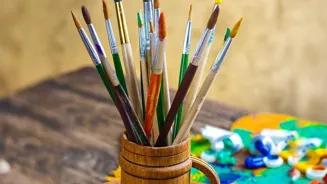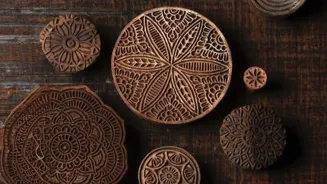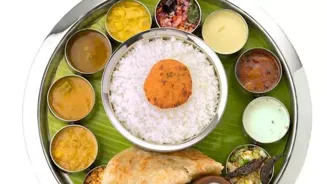Discover the beauty of Indian handicrafts - a celebration of culture and craftsmanship. Read on to explore 8 unique treasures!
India, a land of vibrant culture and rich heritage, is renowned for its exquisite
handicrafts. These handcrafted treasures, passed down through generations, showcase the incredible skills and artistic vision of Indian artisans.
Owning a piece of Indian handicraft is not just about possessing a beautiful object; it's about owning a piece of history, supporting local communities, and celebrating the artistry that defines India. Let's dive into eight unique Indian handicrafts that deserve a place in your home and heart.
Blue Pottery of Jaipur: A Turquoise Dream
Originating from Persia and making its way to Rajasthan, Blue Pottery is a distinctive art form characterized by its vibrant turquoise and cobalt blue hues.
Unlike conventional pottery, it doesn’t use clay; instead, it’s made from a mixture of quartz, powdered glass, borax, and Multani mitti (fuller's earth). This unique composition gives it a translucent quality and a delicate appearance.
Artisans meticulously hand-paint intricate floral patterns, animal motifs, and geometric designs onto the pottery, creating stunning pieces that range from decorative plates and vases to tiles and even doorknobs.
Blue Pottery adds a touch of regal elegance to any space, reflecting the royal heritage of Jaipur. Bringing a piece of this craft will infuse your home with a vibrant charm and serve as a constant reminder of royal history.
The process being completely handmade ensures uniqueness and contributes to its value.
Kalamkari: Stories Woven in Ink
Kalamkari, meaning "pen craft," is an ancient Indian art form involving hand-painting or block-printing on cotton or silk fabric using a kalam (pen) made of a pointed bamboo stick.
There are two main styles of Kalamkari: Srikalahasti style, which relies entirely on hand-painting, and Machilipatnam style, which uses block-printing techniques.
Natural dyes derived from plants and minerals are used to create intricate designs depicting mythological narratives, floral patterns, and scenes from everyday life.
Kalamkari fabrics are used to create sarees, wall hangings, and other decorative items that exude timeless beauty and cultural significance. Artisans practicing this type of work have been recognised globally and their talent is helping to preserve the country's art in the modern era.
Kalamkari's versatility makes it a popular choice for both traditional and contemporary settings.
Warli Painting: Echoes of Tribal Life
Hailing from the Warli tribe of Maharashtra, Warli painting is a form of tribal art that uses simple geometric shapes like circles, triangles, and squares to depict scenes from daily life, rituals, and mythology.
The paintings are traditionally done on mud walls using a white pigment made from rice flour, water, and gum. A single line of figures can create a storyline, painting a beautiful picture of warli lifestyle.
The minimalist style and earthy tones of Warli paintings evoke a sense of simplicity and connection to nature. Today, Warli art has found its way onto various contemporary products, including clothing, home decor items, and stationery.
Madhubani Painting: Vivid Colors and Mythological Tales
Originating from the Mithila region of Bihar, Madhubani painting is characterized by its vibrant colors, bold outlines, and intricate patterns. The paintings typically depict mythological figures, religious symbols, and scenes from nature using natural dyes derived from plants and minerals.
Traditionally, women of the Mithila region created these paintings on the walls and floors of their homes during festivals and ceremonies. Madhubani paintings now adorn sarees, wall hangings, and other decorative items.
The stories told by these paintings offer a glimpse into the rich cultural heritage of the Mithila region. It has gained international recognition and is a recognised and respected art form.
Pashmina Shawls: The Epitome of Luxury
Pashmina shawls, handcrafted from the fine wool of the Changthangi goat found in the high altitudes of the Himalayas, are renowned for their unparalleled softness, warmth, and exquisite craftsmanship.
The wool is hand-spun and hand-woven by skilled artisans in Kashmir, resulting in shawls that are incredibly lightweight yet exceptionally warm. Pashmina shawls are often adorned with intricate embroidery or delicate patterns, making them timeless pieces of wearable art.
Owning a Pashmina shawl is a testament to luxury and a symbol of elegance. It has gained a global demand for its softness and warmth along with the royal feel.
Dhokra Art: Lost Wax Casting Magic
Dhokra is a non–ferrous metal casting using the lost-wax casting technique. This sort of metal casting has been used in India for over 4,000 years and is still used. The earliest known lost wax artefact is the dancing girl of Mohenjo-daro.
The name Dhokra after the Dhokra Damar tribes are the traditional metal smiths of West Bengal and Odisha known for their craftsmanship. Their technique of lost wax casting is named after their tribe, hence Dhokra metal casting.
Dhokra artifacts mainly include figurines of Gods and Goddesses, human figures, animals and birds.
Wood Carving of Saharanpur: Intricate Details in Timber
Saharanpur, a city in Uttar Pradesh, is famous for its exquisite wood carving. Artisans use seasoned sheesham wood to create intricate designs on furniture, screens, and decorative objects.
Floral motifs, geometric patterns, and scenes from nature are meticulously carved by hand, showcasing the skill and artistry of Saharanpur's master craftsmen. Wood Carving of Saharanpur adds a touch of traditional elegance to any home.
Channapatna Toys: Colorful Creations for All Ages
Channapatna, a small town in Karnataka, is known as the "Toy Land of India" for its vibrant and eco-friendly wooden toys. These toys are made from sustainably sourced wood, lacquered with natural dyes, and hand-painted with intricate designs.
Channapatna toys are not only fun and educational but also safe for children, making them a popular choice for parents seeking traditional and sustainable playthings.
Artisans are constantly innovating, blending traditional knowledge with newer trends, making their product an important element that reflects India.
Owning these handicrafts is a celebration of culture and makes you an element of preserving skills.
These unique pieces each tell a story and showcase the immense talent of Indian artisans.
By welcoming these treasures into your home, you are not only adding beauty and character to your living space but also supporting the livelihoods of skilled craftsmen and preserving India's rich cultural heritage and artistic legacy.
AI Generated Content. Glance/InMobi shall have no liability for the content










